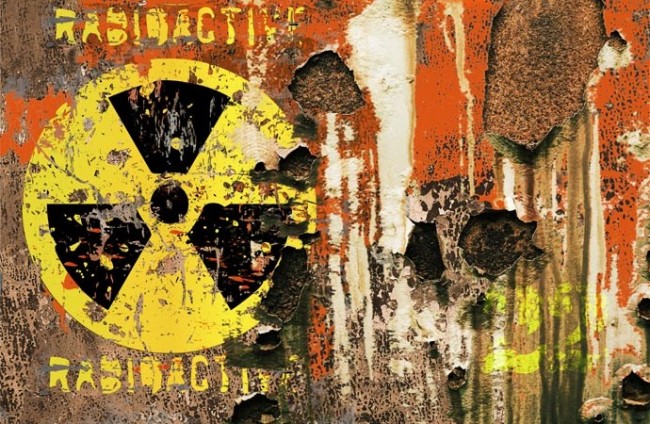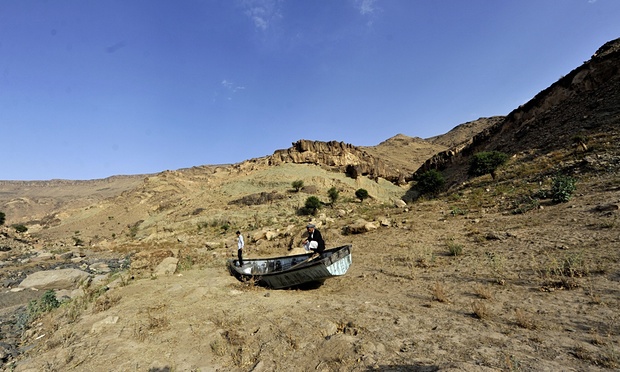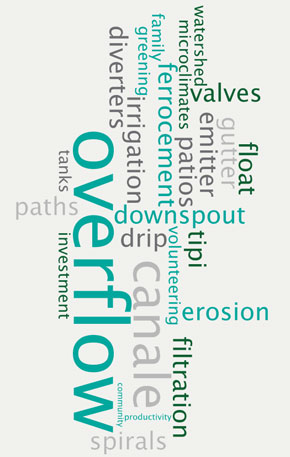The PermaDesign Weblog, with Nate Downey and Melissa McDonald!
Roof-Reliant Landscaping™ Step 18A: Water Distribution - Sump Pump
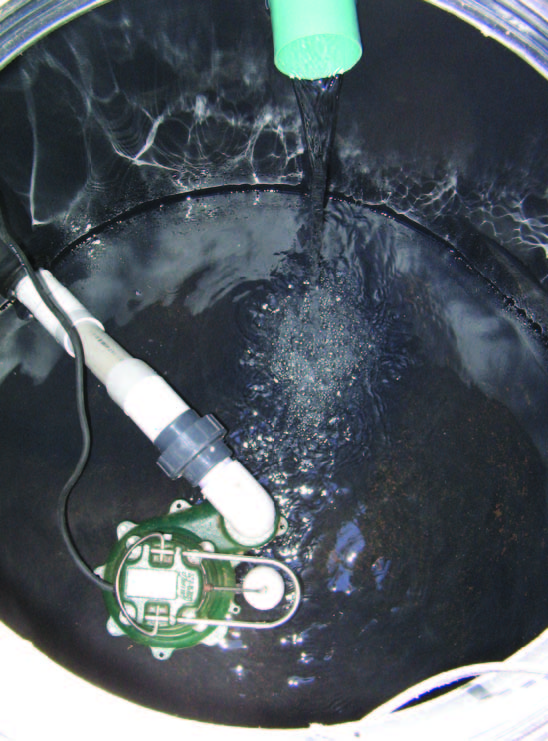
Above: A sump pump must be submerged in water in order to work.
Particular attention must be paid to the distribution component of every cistern system because this final part of the process of rooftop rainwater harvesting is typically responsible for more water waste than the other three components (collection, conveyance and storage) combined. For example, when a pressurized pipe cracks 24” below grade, it will often go unnoticed until large quantities of water have already been wasted. Likewise, when a pump or automatic irrigation system gets stuck in the “ON” position, it doesn't take long for a full cistern to become empty. And if you get distracted and forget to turn off a hose running in your garden, your entire cistern could be drained in a short period of time.
The distribution of harvested water can be divided into two basic processes: the pumping of and delivery of water. Most conventional cistern systems require a pump to provide hydraulic lift and either a garden hose or a drip irrigation system to deliver water to the root zones of plants. Distribution systems can be manually operated, or they can be easily automated for an additional cost.
This blog provides an overview of the components and functions of typical rainwater harvesting distribution systems.
02/27/2016 | (0) Comments
Roof-Reliant Landscaping™ Step 17F: Water Storage - Cistern Materials
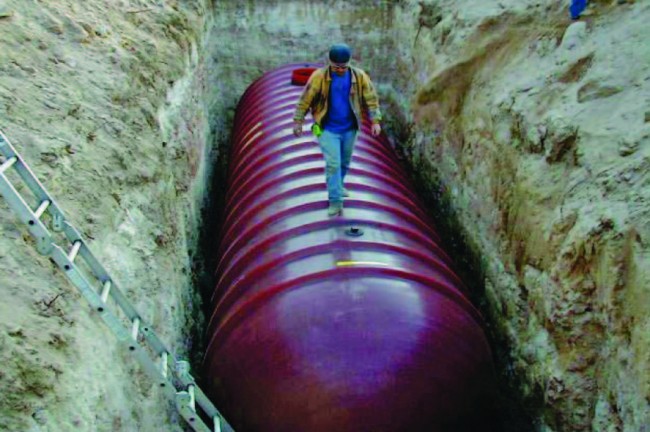
Above: A fiberglass tank being installed.
Cistern Materials
Water-storage vessels come in a wide variety of materials, ranging from high-density polyethylene, epoxy-coated steel and fiberglass on the high-tech side to wood, rock and concrete on the low-tech side. Each type of material has its advantages as well as disadvantages. The following alphabetical list does not endorse any one material or system over any other.
Concrete
Even taking into account the rising price of concrete in recent years, reinforced concrete tanks can be an economical choice. Such tanks can be custom-built on-site, or they can be prefabricated off-site. One important advantage of concrete tanks is that they are usually strong enough to support vehicular traffic.
To prevent water from leaching slowly out of the tank, the inside of a concrete tank is often coated with tar. However, tar can leach into your water supply and then subsequently end up in your soil. Your plants will survive, but over time, your soil might suffer from the increased quantity of low level toxins associated with tar.
Concrete can be used in aboveground, partially buried and underground systems. Plastic liners may also be used inside concrete tanks, which solves the problem of tar leaching and helps to prevent potential leaks.
Ferrocement
Ferrocement, often called ferroconcrete, is a form of concrete tank that uses significant amounts of rebar and chicken wire in the form of a skeleton, upon which a specific mixture of sand, cement and water is spread. Since ferrocement is thinner than concrete, it has the potential to be the least expensive of all cisterns. It also has a greater tendency to leak compared to other materials. Such tanks can easily increase the cost of your project if improperly installed or if leaks are not quickly and effectively addressed.
These tanks can be made into almost any shape. They can be used in any of the three relationships to grade (aboveground, partially buried or underground). They are used throughout the developing world with great success, but an onsite ferrocement-tank building project requires serious construction and management skills as well as some significant research.
Fiberglass
Underground fiberglass cisterns are commercially available and start becoming cost-effective in the 5,000- to 10,000-gallon range. You may have to crane an underground fiberglass tank into your hole due to its size (even though it is relatively lightweight), but this is also often true of other cistern materials including concrete and metal. Fiberglass is an extremely durable and long-lasting material that can be patched with relative ease.
Some underground fiberglass tanks can withstand vehicular traffic, which means that placement of the tank underneath a driveway becomes an option. Aboveground fiberglass tanks are available in smaller sizes, but they must be shaded and/or be UV resistant. Fiberglass fittings are integral parts of the tanks themselves, so they are less prone to leaks at pipe connections than are other materials.
Even though cisterns in roof-reliant landscaping are intended to provide water for landscape irrigation only, to be on the safe side you should consider having your tank coated with a USDA-approved food-grade coating. The extra cost is relatively low and the safety benefit is considerable since uncoated fiberglass can be dangerous if ingested. Your plants probably will not mind the leaching from your tank, but in case anyone accidentally puts his/her mouth to your hose to drink, you will not have the ingestion of fiberglass particles to worry about.
Metal
Most metals are not used for storing water due to their cost, but there are two types of metal tanks that can be cost-effective. Galvanized steel, which is often corrugated, is one option. Another option is a non-galvanized underground steel tank, which can be a good choice for large-tank and heavyvehicular- traffic installations.
As aboveground options go, galvanized steel is a good choice from an aesthetic perspective, as the figure below shows. These tanks come in a variety of sizes, but they are not the most durable of cistern materials.
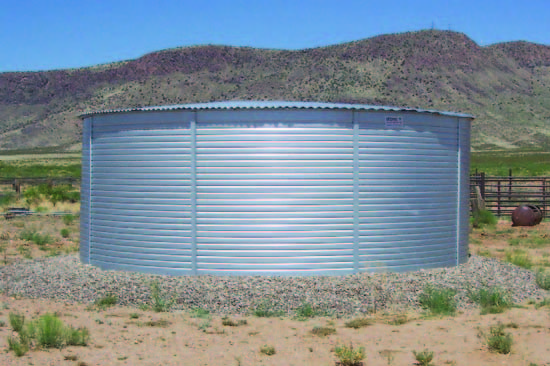
Above: Steel tanks are a cost effective option at 5,000 gallons and larger.
Due to the high expense, underground steel is not an option for small scale projects. Steel tanks begin to become cost effective in the 5,000- to 10,000-gallon range. Steel tanks need to be coated on the outside with coal tar epoxy or another coating or they will rapidly corrode in New Mexico’s alkaline soils.
Plastic
Plastic has become an increasingly common cistern material, in part because it can be very cost effective. It can be used in aboveground, partially buried and underground applications. Plastic tanks do not require any type of internal coating. However, plastic tanks that are aboveground (either fully or partially) and will be exposed to strong sunlight will need an exterior UV-resistant coating. Plastic tanks should be as opaque as possible in order to prevent algae growth. For aboveground applications, plastic tanks are typically molded into one-piece cylinders that stand on flat bottoms.
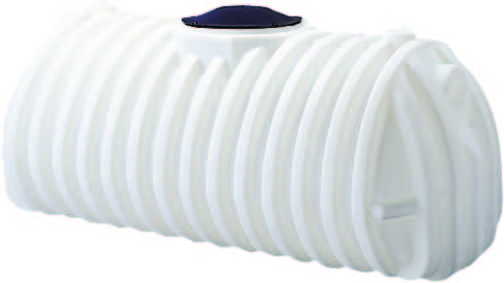
Above: A plastic tank can be very cost effective.
A lightweight and relatively inexpensive material, plastic can be prefabricated in a variety of shapes and sizes. Individual plastic tanks, however, are not available in large sizes, but they can be connected together to attain a large storage capacity for the entire system. (See Figure Below.)
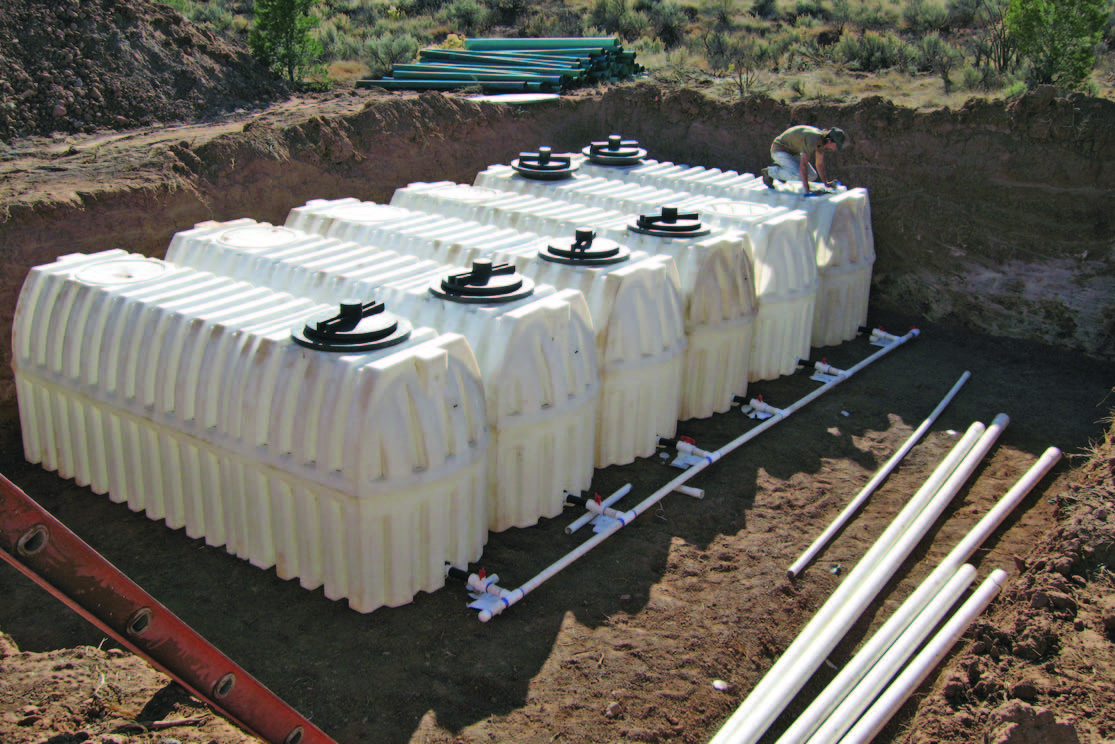
Above:: Tanks can be connected together to create larger storage capacity. These tanks will be connected in parallel, so that an individual tank can be shut off for maintenance or repair without disabling the entire system.
Underground plastic tanks are available in a variety of sizes up to about 2,000 gallons. For structural reasons, many of these plastic tanks require that a percentage of the cistern remains full at all times. Some plastic tanks can be completely emptied, such as the tank shown in the figure below, which has thick tank walls, a round bottom and deeply corrugated sides.
Modular tank systems represent a new development in cistern technology. Modular systems consist of strong but essentially empty plastic blocks that are stacked on top of each other. These blocks effectively create a skeleton, completely enclosed in a plastic liner, which can withstand vehicular traffic.
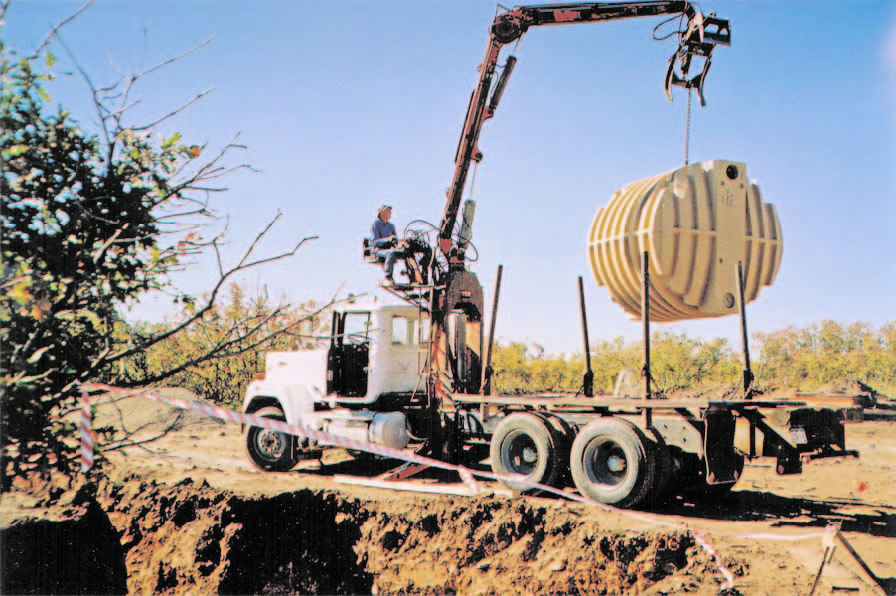
Above: Large tanks must be delivered onsite via truck and lowered into place with a crane. The thick walls of this tank enable it to sit completely empty in the ground.
02/25/2016 | (1) Comments
Land Ethic at Work Workshop
Ethicists and ecologists unite in Minnesota on April 2 thanks to the Aldo Leopold Foundation and other sponsors. Looks like an interesting and productive workshop!
02/25/2016 | (0) Comments
Roof-Reliant Landscaping™ Step 17E: Water Storage - Cistern Placement
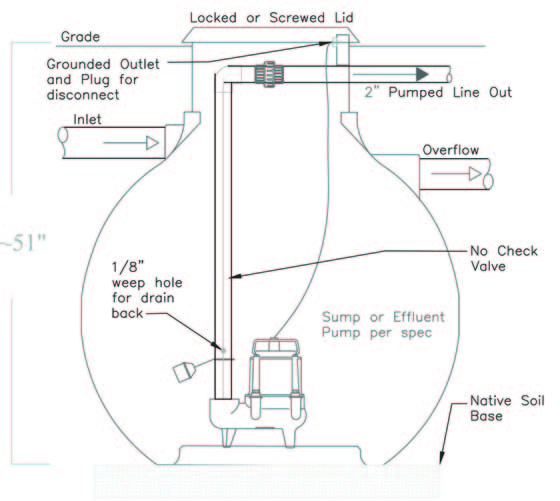
Cistern Placement
To help determine the best location for your cistern, a set of seven guidelines for cistern placement are presented below. These guidelines are intended to help save time and money, as well as to make your whole system as efficient and productive as possible.
While many cistern tanks are added to residential properties after construction of the house has been completed, in new construction cistern design and placement issues should be considered at the beginning of the design process rather than as an afterthought. Designing the cistern system as an integral part of the site can add additional options for cistern locations including within buildings and on a structure’s foundation.
02/23/2016 | (0) Comments
Too Close for Comfort
As the nation rages about the unforgivable water situation in Flint, Michigan, here's a frightening story about the Sandia Radioactive-Waste Landfill in Albuquerque that's too close for comfort to the city's water supply. Groundwater-monitoring wells designed to alert people of nuke-related water-quality problems have been dysfunctional for a very long time, and public officials seem to be giving the ABQ Free Press the silent treatment.
02/22/2016 | (0) Comments
Roof-Reliant Landscaping™ Step 17D: Water Storage - Underground Cisterns
Underground Cisterns
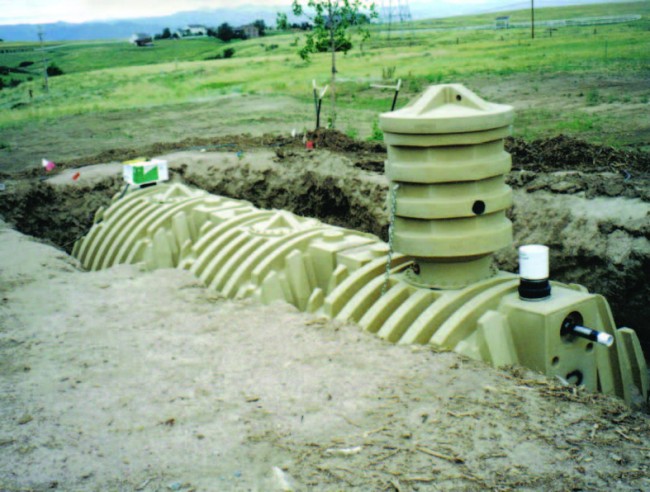
Once this underground cistern is installed and the hole is backfilled with dirt, only the serviceway will be visible. An underground cistern is a water-storage tank that is situated below grade. Here is a description of the advantages and disadvantages associated with underground cistern systems:
Advantages. The advantages of storing water underground are frost protection, invisibility, landscape versatility, less chance of algae growth in the tank and cooler water temperatures.
02/20/2016 | (0) Comments
World Water Stress
This is a great article in The Guardian that shows the massive challenge the globe faces as we further pollute and draw down our most precious resource.
02/17/2016 | (0) Comments
Roof-Reliant Landscaping™ Step 17C: Water Storage - Partially Buried Cisterns
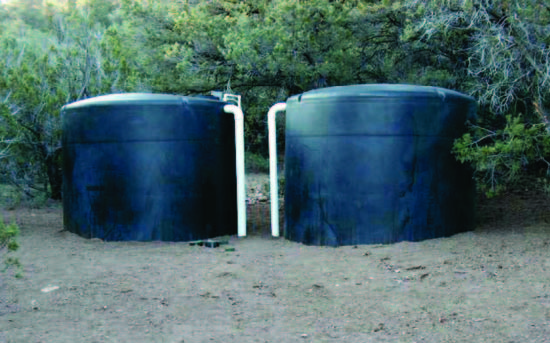
Two partially buried cisterns
A partially buried cistern is a water-storage tank situated such that the bottom portion of the cistern and its pressurized pipe are protected by the soil from freezing. The remainder of the tank is exposed to the elements (particularly sunlight).
02/16/2016 | (0) Comments
PC Is Back!
Permaculture is back in the NY Times! http://www.nytimes.com/2013/02/14/garden/a-permaculture-love-story.html?_r=0
02/15/2016 | (0) Comments
A Drop in the Bucket
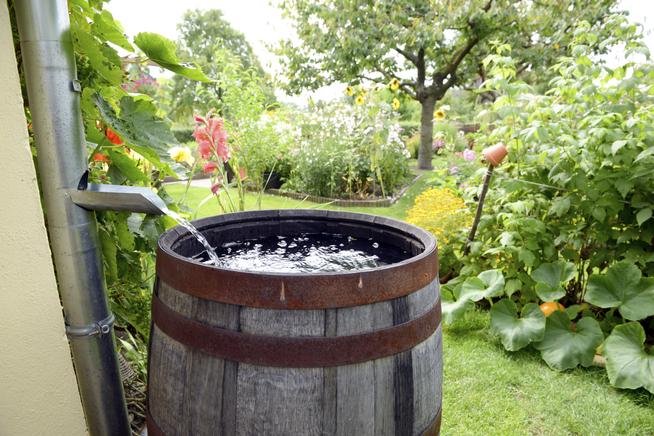
It's a drop in the bucket. Colorado should allow many more forms of water harvesting, but the state is way behind the times on this important issue.
http://www.denverpost.com/editorials/ci_29510442/colorado-should-give-green-light-rain-barrels
02/15/2016 | (0) Comments

